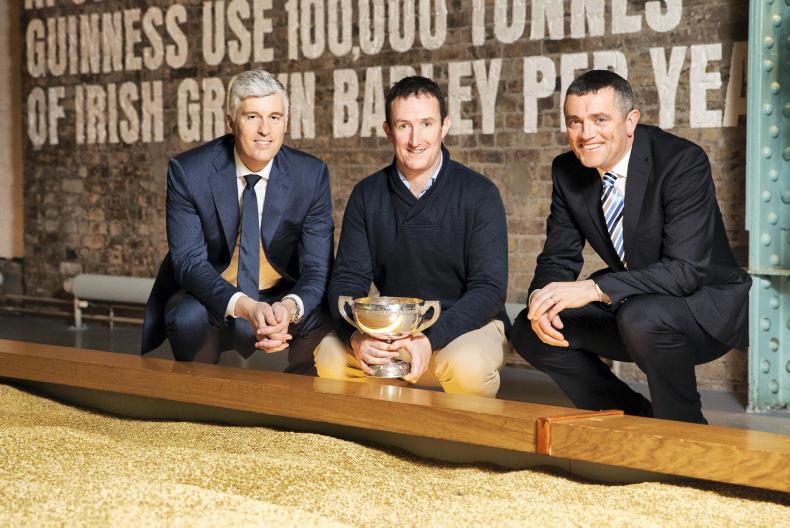This year will be remembered as one of the most difficult growing years in a generation, and proved a particular challenge for malting barley growers. The late spring, followed by the prolonged drought meant that achieving this year’s malting specs wasn’t possible for many.
Malting barley intake at Boortmalt Ireland, the malting barley division of the Axereal group, Europe’s largest grain co-operative was back 50% this year.
Listen to "Boortmalt top malting barley and seed growers announced" on Spreaker.
This difficult year was recognised at the Irish Malting Barley Excellence Awards in the Guinness Storehouse. Here, the top growers from the company’s 900-strong growers base were whittled down to 12, where the overall winner was announced.
While rejection rates due to protein levels were significantly higher this year in every area, there were some successes in the new territories the company has expanded into in 2018 such as the northwest.
A period of growth
Aidan Crowe, operations director at St James’ Gate opened the awards by acknowledging the tough season experienced by malting barley growers this year. Brewing this year’s malt may prove to be a challenge in the plant he added.
However, Crowe stated that this is a real time of growth for Irish beers and whiskeys, with the first ever distillery at the site due to open in early 2019.
Diageo uses more than 130,000t of barley each year, with around 300t used each day to brew Guinness. He stated the importance of a 100% Irish malting barley supply chain.
The need to adapt
Boortmalt Group CEO Yvan Schaepman spoke of the ever-changing farming landscape and the need for the business to adapt. This was demonstrated by the renegotiation of the existing price contracts earlier this year in response to the higher feed barley prices. He stated: “I don’t think the pricing model has failed, in the early years it was quite an innovative model.”
“We’re in an environment that continues to change and, as a result, the pricing model needs to adapt,” he stated.
Despite introducing a derogation and rising acceptable protein levels to 12%, total intake was still significantly back. The balance of supply will be made up by imported grains this year.
Schaepman reassured guests that he remains confident about a 100% sustainable Irish barley supply chain, and their vision to make Irish malting barley the most profitable crop to Irish growers however.
He concluded by stating that it’s important to ensure the economics of malting barley is right for growers and that it wasn’t just related to price, citing the new collaboration with Teagasc as key to improving the agronomy of the crop.
Growers await 2019
pricing deal
IFA grain chair Mark Brown acknowledged Boortmalt and Diageo for renegotiating the agreed deal this year and topping up the final paid price, as well as the introduction of a distilling premium. This came amid yield reductions of 30%-50% he stated. Growers now await news of the 2019 pricing structure, of which negotiations were still ongoing at the time of the awards.
“Growers can only continue to supply premium malting barley at a sustainable price, and we make no apology for asking for this,” he remarked.
Wexford success
Padraig Kehoe of The Ballagh, Enniscorthy, Co Wexford claimed the top prize for his malting barley crop this year. Wexford, like many of the key malting barley growing areas, suffered the brunt of the drought conditions and received virtually no rain all season. Despite this, Padraig’s average malting barley yield was 2.2t/ac with no loads testing above 10% protein content.
The Wexford man, whose first year it was to make it to the final, expressed his surprise at winning the award.
Having toured the factory at morning, he thought it was important to see the brewing process firsthand.
“It give the brewers a chance to explain the problems they face on their end,” he remarked.
His sowing was delayed until late April/early May this year. He applied his nitrogen as soon as possible and cut rates back to around 130-135kg N/ha. He cut back on fungicide rates in order to save on spend but increased spend on trace element sprays to help crop development as best it could.
Francis and Phillip Kehoe from New Ross took home the top prize in the seed-growing category. It’s the attention to detail that makes the difference in crop production, especially in a year like this, according to Phillip. His crops also suffered the full effects of the drought and while crop establishment was a worry this year, disease pressure was low.
Read more
Wexford farmer wins malting barley excellence award
Listen: malting barley intake back 50% – Boortmalt boss
This year will be remembered as one of the most difficult growing years in a generation, and proved a particular challenge for malting barley growers. The late spring, followed by the prolonged drought meant that achieving this year’s malting specs wasn’t possible for many.
Malting barley intake at Boortmalt Ireland, the malting barley division of the Axereal group, Europe’s largest grain co-operative was back 50% this year.
Listen to "Boortmalt top malting barley and seed growers announced" on Spreaker.
This difficult year was recognised at the Irish Malting Barley Excellence Awards in the Guinness Storehouse. Here, the top growers from the company’s 900-strong growers base were whittled down to 12, where the overall winner was announced.
While rejection rates due to protein levels were significantly higher this year in every area, there were some successes in the new territories the company has expanded into in 2018 such as the northwest.
A period of growth
Aidan Crowe, operations director at St James’ Gate opened the awards by acknowledging the tough season experienced by malting barley growers this year. Brewing this year’s malt may prove to be a challenge in the plant he added.
However, Crowe stated that this is a real time of growth for Irish beers and whiskeys, with the first ever distillery at the site due to open in early 2019.
Diageo uses more than 130,000t of barley each year, with around 300t used each day to brew Guinness. He stated the importance of a 100% Irish malting barley supply chain.
The need to adapt
Boortmalt Group CEO Yvan Schaepman spoke of the ever-changing farming landscape and the need for the business to adapt. This was demonstrated by the renegotiation of the existing price contracts earlier this year in response to the higher feed barley prices. He stated: “I don’t think the pricing model has failed, in the early years it was quite an innovative model.”
“We’re in an environment that continues to change and, as a result, the pricing model needs to adapt,” he stated.
Despite introducing a derogation and rising acceptable protein levels to 12%, total intake was still significantly back. The balance of supply will be made up by imported grains this year.
Schaepman reassured guests that he remains confident about a 100% sustainable Irish barley supply chain, and their vision to make Irish malting barley the most profitable crop to Irish growers however.
He concluded by stating that it’s important to ensure the economics of malting barley is right for growers and that it wasn’t just related to price, citing the new collaboration with Teagasc as key to improving the agronomy of the crop.
Growers await 2019
pricing deal
IFA grain chair Mark Brown acknowledged Boortmalt and Diageo for renegotiating the agreed deal this year and topping up the final paid price, as well as the introduction of a distilling premium. This came amid yield reductions of 30%-50% he stated. Growers now await news of the 2019 pricing structure, of which negotiations were still ongoing at the time of the awards.
“Growers can only continue to supply premium malting barley at a sustainable price, and we make no apology for asking for this,” he remarked.
Wexford success
Padraig Kehoe of The Ballagh, Enniscorthy, Co Wexford claimed the top prize for his malting barley crop this year. Wexford, like many of the key malting barley growing areas, suffered the brunt of the drought conditions and received virtually no rain all season. Despite this, Padraig’s average malting barley yield was 2.2t/ac with no loads testing above 10% protein content.
The Wexford man, whose first year it was to make it to the final, expressed his surprise at winning the award.
Having toured the factory at morning, he thought it was important to see the brewing process firsthand.
“It give the brewers a chance to explain the problems they face on their end,” he remarked.
His sowing was delayed until late April/early May this year. He applied his nitrogen as soon as possible and cut rates back to around 130-135kg N/ha. He cut back on fungicide rates in order to save on spend but increased spend on trace element sprays to help crop development as best it could.
Francis and Phillip Kehoe from New Ross took home the top prize in the seed-growing category. It’s the attention to detail that makes the difference in crop production, especially in a year like this, according to Phillip. His crops also suffered the full effects of the drought and while crop establishment was a worry this year, disease pressure was low.
Read more
Wexford farmer wins malting barley excellence award
Listen: malting barley intake back 50% – Boortmalt boss






 This is a subscriber-only article
This is a subscriber-only article










SHARING OPTIONS: